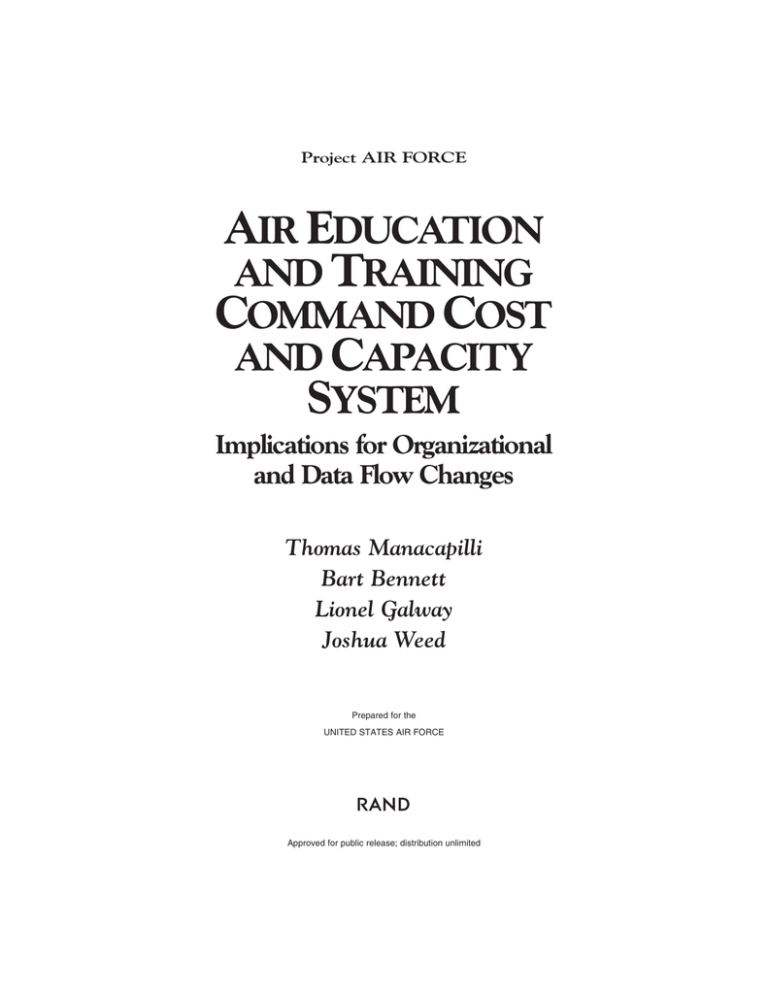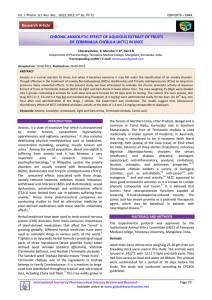
Project AIR FORCE
AIR EDUCATION
AND TRAINING
COMMAND COST
AND CAPACITY
SYSTEM
Implications for Organizational
and Data Flow Changes
Thomas Manacapilli
Bart Bennett
Lionel Galway
Joshua Weed
Prepared for the
UNITED STATES AIR FORCE
R
Approved for public release; distribution unlimited
The research reported here was sponsored by the United States Air Force
under Contract F49642-01-C-0003. Further information may
be obtained from the Strategic Planning Division, Directorate of
Plans, Hq USAF.
Library of Congress Cataloging-in-Publication Data
Air Education and Training Command cost and capacity system : implications for
organizational and data flow changes / Thomas Manacapilli ... [et al.].
p. cm.
Includes bibliographical references.
“MR-1797.”
ISBN 0-8330-3503-7 (pbk. : alk. paper)
1. United States. Air Force. Air Education and Training Command—Evaluation.
2. Aeronautics, Military—Study and teaching—United States—Evaluation. I.
Manacapilli, Thomas.
UG638 .A65 2003
358.4'15'0684—dc22
2003024475
The RAND Corporation is a nonprofit research organization providing
objective analysis and effective solutions that address the challenges
facing the public and private sectors around the world. RAND’s
publications do not necessarily reflect the opinions of its research clients
and sponsors.
R® is a registered trademark.
© Copyright 2004 RAND Corporation
All rights reserved. No part of this book may be reproduced in any form
by any electronic or mechanical means (including photocopying,
recording, or information storage and retrieval) without permission in
writing from RAND.
Published 2004 by the RAND Corporation
1700 Main Street, P.O. Box 2138, Santa Monica, CA 90407-2138
1200 South Hayes Street, Arlington, VA 22202-5050
201 North Craig Street, Suite 202, Pittsburgh, PA 15213-1516
RAND URL: http://www.rand.org/
To order RAND documents or to obtain additional information, contact
Distribution Services: Telephone: (310) 451-7002;
Fax: (310) 451-6915; Email: order@rand.org
SUMMARY
The mission statement of the Air Education and Training Command
(AETC)—“recruiting, training, and educating professional airmen to
sustain the combat capability of America’s Air Force”—provides a
good starting point for developing information requirements for
training management. Combat capability is directly affected by the
quantity and quality of trained personnel. And the provision of sufficiently trained Air Force personnel relies upon effective management of training production and, in turn, the cost and capacity of the
training system. Arguably, AETC currently has difficulty assembling
and using cost and capacity data in managing its training pipeline,
particularly for technical training. We find that this is partly due to
an organizational structure that is both too complex and too unclear
and has overlapping decisionmaking responsibilities.
We developed a four-level model of management to evaluate the flow
of data in the AETC training pipeline:
1. The corporate level validates and arbitrates training requirements.
(See p. 18.)
2. The strategic training management level concentrates on the
training system’s long-term effectiveness. (See p. 19.)
3. The training management level handles the day-to-day operations
of training. (See p. 20.)
4. The direct training level delivers training in the classrooms.
(See p. 21.)
xiii
xiv
AETC Cost and Capacity System
Most data needed for informed decisionmaking in AETC exist at the
bottom two levels but often do not flow adequately to the top two
levels. Part of the problem is that strategic training management is
split among multiple organizations: no central organization has the
manpower to work capacity issues (e.g., addressing surge or limiting
constraints), reduce Trained Personnel Requirements (TPR) shortfalls, evaluate quality information, develop cost methodologies for
planning, and serve as the single advocate for technical training
in the Air Force. As a result, data flow among training management
organizations is ad hoc. (See pp. 33–53.)
We looked at how strategic training management was handled in
other training organizations to help motivate our model and provide
lessons for AETC. The Army has organized strategic training management at the functional level, with no intervening organizations
between it and training management. Currently, the Navy has a very
decentralized training operation but is conducting an extensive revision effort to correct disconnects discovered during its Executive
Review of Naval Training. Our case studies of four major companies
with large training programs show that although these companies
employ different organizational designs, all have a clearly defined
senior person responsible for organizing training and making strategic decisions. (See pp. 14ff.)
We recommend organizational and process changes at the strategic
training management level (mostly residing in HQ AETC). We believe that a consolidation of the strategic management functions,
within an organization probably headed by a two-star general,
would, among other things, resolve many current data flow problems. We also recommend that methodological tools be developed,
including simulations to evaluate tradeoffs in the training pipeline,
in order to improve data combination and interpretation, particularly in the area of cost. It is also clear that AETC should have a central data “warehouse” for collecting cost and capacity data. We believe that a “real-time” minute-by-minute data tracking system is not
warranted and would not be cost-effective. Finally, we recommend
that cost and capacity data be fit into the AETC Decision Support
System/Technical Training Management System (ADSS/TTMS) architecture already under development for training production data.
(See pp. 56–60.)







